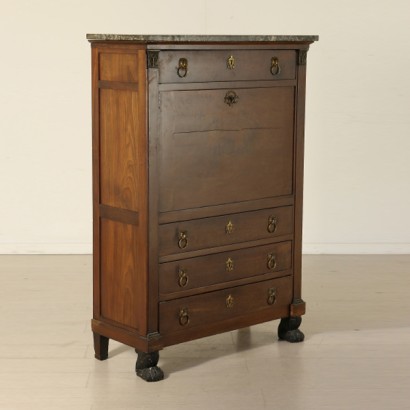Secretaire Empire
Features
Style: Empire (1804-1815)
Age: 19th Century / 1801 - 1900
Origin: Toscana, Italy
Main essence: Mahogany
Material: Solid Mahogany
Description
Secretaire Empire comprising four drawers one under floor and flap door with internal scarabattolo. Inside compartments and drawers. Veneered with mahogany, pilasters with capitals in bronze, Leonine protome shaped Sockets; Lion claw-foot carved and ebonized instruments. Interior in poplar and oak, top in black and white.
Product Condition:
Requires small restoration and resumption of polishing.
Dimensions (cm):
Height: 142
Width: 97
Depth: 42
Additional Information
Notes historical bibliographic
With Elisa Bonaparte, Grand Duchess of Tuscany, arrive in Florence of the workers (Jean Baptiste Yuof, above all) and a taste of decorating, but also a build quality, that refer fully to the Empire style in Paris. In this case, the typical Tuscan building is embellished with some quality Parisian building techniques that raise the quality, see the drawer construction, the quality of locks, the refinement of bronze especially the handles of the scarabattolo. some items, like the bronzes, feet and draft of mahogany are reflected in the bibliography, see: Simone Chiarugi, furniture workshops in Tuscany, and Henry Hill, the 1994 S.P.E.S., mobile ... of court in Lucca, Pacini Fazzi ed. 2005Style: Empire (1804-1815)
Decorative style of the furniture that is affirmed under the Empire of Napoleon Bonaparte, that is, between 1799, the year of his election as consul, and 1815, the year of his definitive defeat.It has many elements of continuity with the previous Direttorio style, in the more general Neoclassical climate, which derived from the study of classical antiquity the forms and models to be inspired in the creation of furniture.
The peculiar feature of this style is a greater grandeur and courtesy of the furnishings, which had to convey the grandeur of the French nation to the world, hence the name Empire style.
The furniture is characterized by straight, majestic and massive lines, adorned with motifs dear to Napoleon such as bees, eagles, large Ns surrounded by laurel, and, after the Egyptian campaign, many elements taken from Egyptian art.
He prefers the flat bronze decorations, often gilded, to the refined carvings of previous years.
The typical essence of Empire furniture is mahogany.
Find out more with our insights:
Classic Monday: How society influences the taste in furnishings
Classic Monday: Empire, one style of furniture with political purposes
Classic Monday: in the Empire bed roots of culture
Classic Monday: the timeless charm of a toilet Empire




























